
The Sun Valley Pavilion was built at a resort in Sun Valley, ID, to offer guests an outdoor amphitheater where they can sit and listen to summer concerts. The facility features Este Light Roman travertine, which was quarried and fabricated by Mariotti Carlo & Figli S.p.A. of Tivoli, Italy.
With the rugged peaks of the Rocky Mountains and an equally impressive landscape, Sun Valley, ID, is a majestic place that is steeped in history. Often referred to as the “American Shangri-La,” the area has become a thriving resort community - offering visitors a wealth of hotels and restaurants, outdoor activities and entertainment. The most recent addition to the region is the Sun Valley Pavilion - a world-class outdoor concert facility that is connected to its surroundings by its impressive stone architecture. The choice of Roman travertine employed for the structure was influenced by its use on the Getty Center in Los Angeles, CA, and ancient buildings such as the Coliseum in Rome, Italy. The material was quarried and fabricated by Mariotti Carlo & Figli S.p.A. of Tivoli, Italy.
The area of Sun Valley was orginally discovered by Count Felix Schaffgotsch, who was under the hire of Union Pacific Railroad chairman Averell Harriman, in 1935. It was originally an old mining town called Ketchum. After sharing his findings with Harriman, 4,300 acres of what soon would become Sun Valley was purchased. Within seven months, construction was completed, and the resort opened to the public in the winter of 1936. It soon became a hot spot for many Hollywood celebrities and European dignitaries. In 1977, ownership was passed to R. Earl Holding, who has lavishly refurbished guest accommodations and amenities through the years, with the latest being the new music pavilion.
“We were approached in 2006 to develop a performance pavilion,” said Nic Goldsmith, Senior Principal and Project Director of FTL Design Engineering Studio in New York, NY, the design architect for the project. “They have a summer symphony, which gives free concerts on the lawn of the resort. They were using a temporary set-up, and they realized there was a need for something more permanent.”
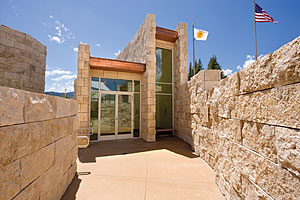
“For travertine, it is a pretty strong stone,” said Nic Goldsmith, Senior Principal and Project Director of FTL Design Engineering Studio in New York, NY. “One thing that attracted me to this was it has a real honey color. It’s beautiful and warm, and part of the original color palette. It goes well with the copper and natural elements.”
Designing the structure
Once commissioned for the project, Goldsmith and his design team scouted the campus to find the most appropriate area for the new music pavilion. “This area made the most sense,” he said. “It is in a central area. Because it is a seasonal facility, we wanted it to have a smaller footprint in the winter and a larger one in the summer when the concerts are going on.”According to Goldsmith, the stone walls of the 21,000-square-foot facility were designed to look like they are protruding from the earth. “The walls of stone come out of the ground and create the chamber space and then fade back into the ground,” he said. “They became a significant element in the design. The client looked at all sorts of stone, and really liked the stone at the Getty Center Museum. They visited the travertine quarries at Mariotti. It’s a beautiful stone. Mr. Mariotti mentioned that it was used for all the curbs in Rome back in the early days.”
Where the stage of the music pavilion is located, a wooden shell was created, which would be an asset when burdened with high snow loads, explained the architect. “We created a cable net structure,” said Goldsmith. “There is wood with copper cladding over the actual chamber and a tensile membrane over the seating areas. There is a bowl-type seating that creates a more intimate space for the listeners.”
In addition to the 1,500-seat amphitheater, a surrounding park provides space for approximately 2,500 concert-goers to sit on the lawn. Providing excellent acoustics was one of the priorities of the pavilion’s design, and as a result, the same clarity can be heard on lawn seating as in the amphitheater, according to the design team.
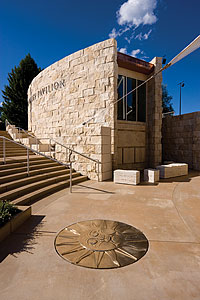
The numerous radial stone walls presented one of the most challenging aspects of the stone installation, which was performed by Kepco+ of Salt Lake City, UT.
Selecting the stone
Almost 33,000 square feet of Este Light Roman travertine was utilized in the construction of the Sun Valley Pavilion. “For travertine, it is a pretty strong stone,” said Goldsmith. “One thing that attracted me to this was it has a real honey color. It’s beautiful and warm, and part of the original color palette. It goes well with the copper and natural elements.”The local architectural firm of Ruscitto/Latham/Blanton Architectura, P.A. worked closely with R.E. Holding, owner of the Sun Valley Co., to determine the specific stone used for the project. The cleft-faced finish of the Roman travertine was a perfect complement to the mountainous environment. To further blend with the surrounding habitat, an unfilled honed finish was given to the stone caps and ends of the site walls, and the joints between the stones were detailed to enhance the music pavilion’s rugged aesthetics.
“In this particular application, the cleft-faced travertine was selected to portray a rugged look, yet the joints were left open to give the stone a contemporary and sophisticated interpretation more suitable for the symphony,” said Bruce Knaphus of KEPCO+ in Salt Lake, UT, the stone installation contractor for the project. “The schedule was very compressed, so KEPCO+ worked very closely with the owner and the architect to make quick decisions. We flew to Rome to select the stone.”
In total, 12,002 travertine pieces were fabricated by Mariotti Carlo & Figli, S.p.A., which also extracted the material from its own quarries in Tuscany. All of the travertine was crosscut, and on average, each piece weighs approximately 160 pounds and measures 14 5/8 x 29 5/8 inches in size - with stone thicknesses varying from 4 to 11 cm.
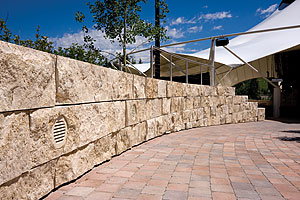
“To meet the schedule, we had to have multiple crews installing various areas of the project simultaneously,” said Bruce Knaphus of Kepco+. “The crews had to set each stone meticulously so that when the installation was complete, all of the walls would tie in together correctly.”
Installing the travertine
One of the most challenging aspects of the project was that the pavilion’s design included only one straight wall. The rest were radial, and each one has a different radius. “Our in-house engineering and CAD team was able to produce the shop drawings very quickly so that fabrication could begin,” said Knaphus. “One of the most complicated aspects of the installation was that all of the walls were radial, yet the project was very spread out. To meet the schedule, we had to have multiple crews installing various areas of the project simultaneously. The crews had to set each stone meticulously so that when the installation was complete, all of the walls would tie in together correctly.”To create the appearance of thick cubic stones at the corners and end walls, mitered corners were chosen. The split-faced mitered corners had to be double cut, or butterflied, from a single piece of stone and then joined with epoxy so that the finish and shading would match at the corners.
In addition to appearance, there was also an underlying reason for having open joints. “While leaving the joints open is not a typical method of installation, it is utilized on occasion, as with this project, for aesthetic purposes,” said Jeremy Simmonds, also of KEPCO+. “Travertine is a porous stone, and with it being in a harsh mountainous climate, the stone had to be able to breathe and allow moisture to leave so that the freeze/thaw cycle would be avoided. Having open joints, particularly on the caps, allowed any moisture to escape.”
Prior to installation, all of the stone anchors were painted black so they would be invisible to the naked eye. “Anytime we have a project that calls for open joints, the anchors are painted for aesthetic purposes,” explained Simmonds. “On this project in particular, patrons are able to walk directly up to the stone walls, so it was critical that the anchors be invisible.”
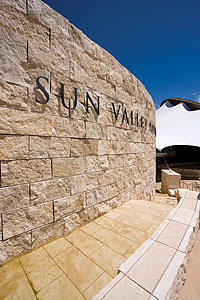
The cleft-faced travertine was selected to portray a rugged look, yet the joints were left open to give the stone a contemporary and sophisticated appearance, according to Knaphus.
Meeting a deadline
According to Goldsmith, construction of the Sun Valley Pavilion was completed in under a year. A total of 30 containers of travertine was installed in just 10 weeks.“It really was phenomenal for a project of that size,” he said. “They really compressed it, and they had crews working day and night. It had to be ready for the opening in July of 2008.”
In the end, all those involved with the project were pleased with the results, said Goldsmith. “I remember on Opening Night, I was talking with the musicians,” he said. “They loved the acoustics with the adjustable wood panels, and they were happy that they were able to tune the acoustics and keep a bright sound space essential for classical music.
“The community felt that it gave them a building of merit - providing a meeting place that added something for generations to the community of Sun Valley,” the architect went on to say. And, the pavilion’s impressive stonework earned Kepco+ an “Award of Merit” in the Commercial Exterior category of the 2009 Pinnacle Awards, which are held annually by the Marble Institute of America.
Sun Valley Pavilion - Sun Valley, ID
Owner: Sun Valley Co., Sun Valley, IDDesign Architect: FTL Design Engineering Studio, New York, NY
Project Architect: Ruscitto/Latham/Blanton Architectura, P.A., Sun Valley, ID
General Contractor: Intermountain Construction, Inc.
Stone Supplier/Fabricator: Mariotti Carlo & Figli S.p.A., Tivoli, Italy
Stone Installer: KEPCO+, Salt Lake City, UT
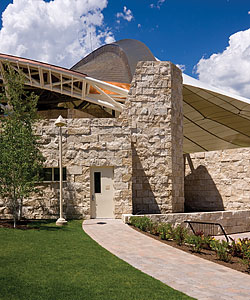
“Travertine is a porous stone, and with it being in a harsh mountainous climate, the stone had to be able to breathe and allow moisture to leave so that the freeze/thaw cycle would be avoided,” explained Jeremy Simmonds, also of KEPCO+, when explaining reasons other than aesthetics for the open joints. “Having open joints, particularly on the caps, allowed any moisture to escape.”

Each piece of travertine was crosscut, and on average, weighs approximately 160 pounds and measures 14 5/8 x 29 5/8 inches in size - with stone thicknesses varying from 4 to 11 cm.
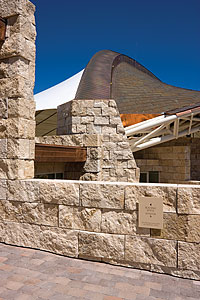
The cleft-faced finish of the Roman travertine was a perfect complement to the mountainous environment.
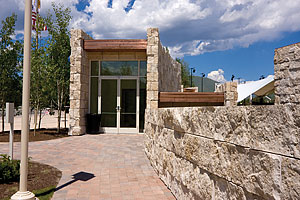
To create the appearance of thick cubic stones at the corners and end walls, mitered corners were chosen.
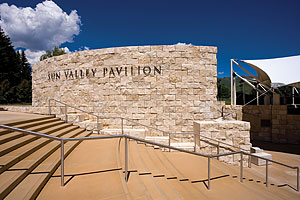
The split-faced mitered corners had to be double cut, or butterflied, from a single piece of stone and then joined with epoxy so that the finish and shading would match at the corners.
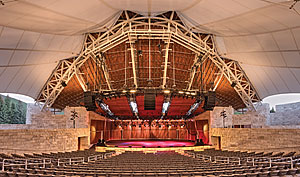
Almost 33,000 square feet of Este Light Roman travertine was utilized in the construction of the Sun Valley Pavilion.
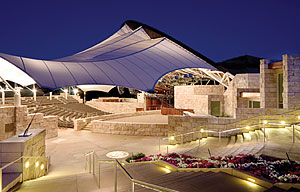
Construction of the Sun Valley Pavilion was completed in under a year. A total of 30 containers of travertine was installed in just 10 weeks.
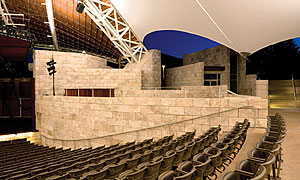
Prior to installation, all of the stone anchors were painted black so they would be invisible to the naked eye. “Anytime we have a project that calls for open joints, the anchors are painted for aesthetic purposes,” explained Simmonds. “On this project in particular, patrons are able to walk directly up to the stone walls, so it was critical that the anchors be invisible.”
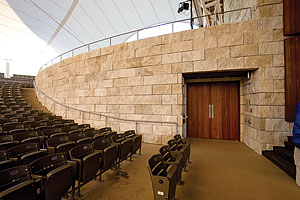
According to Goldsmith, the stone walls of the 21,000-squarefoot facility were designed to look like they are protruding from the earth. “The walls of stone come out of the ground and create the chamber space and then fade back into the ground,” he said. “They became a significant element in the design.”
